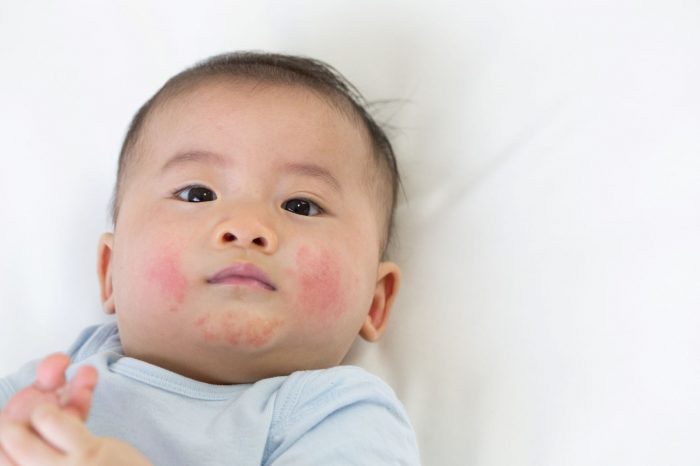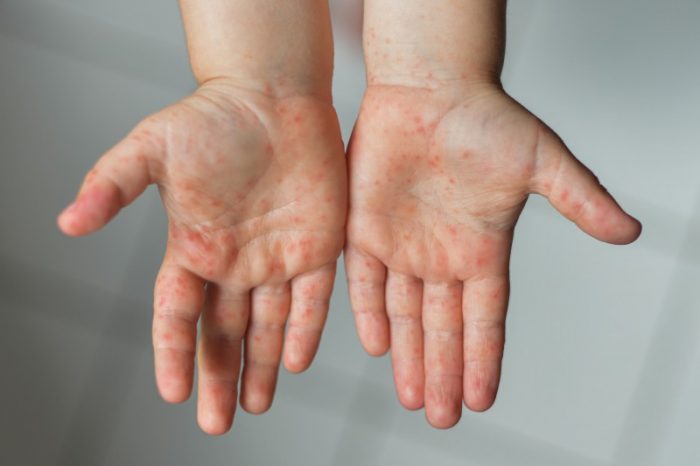
When it comes to rashes, Seattle Children’s dermatologist Dr. Markus Boos is like a detective. When he meets with patients and families who are concerned about a rash, Boos first listens to their story, looks at their skin for clues and then works with them to determine the cause.

“When I meet with families, there are two important things I always want to emphasize in order to help allay any anxiety they may have,” Boos said. “The first is that we see rashes all the time – literally every day. Their child often has a condition that many other children do as well. Secondly, I reaffirm that I’m glad they came to see me, no matter how mild or severe their skin condition is. I’m a parent and I get it. It’s distressing when something is wrong with your child, and I’m here to help.”
Most of the rashes Boos sees are manageable with topical medications or observation and there is usually no cause for concern, but there are some cases when parents should seek treatment more urgently.
“What should make you worry about a rash is when there are symptoms that involves systems outside the skin, like high fever, vomiting or lethargy,” Boos said. “Those things definitely make me more concerned. For the most part, the majority of common skin rashes won’t have those.”
Rashes caused by medications are another type of rash that Boos says require early identification and treatment.
“Drug rashes are things you wouldn’t want to miss,” Boos said. “The ones we worry about are the ones that blister, cause skin pain, and that involve the eyes, mouth or other mucosal surfaces. Children with severe drug reactions often are very ill-appearing and may have a fever, as well. I’d be quicker to involve experts in the emergency room in those cases.”
Typically, Boos says drug rashes occur about 1 to 2 weeks after starting a new medication.
Below, Boos breaks down the most common rashes he sees at Seattle Children’s.
Eczema and atopic dermatitis

Atopic dermatitis is a genetically based form of eczema. It can cause scaly and itchy skin that is localized to flexural areas and is often accompanied by darkening or redness of the skin. Boos says atopic dermatitis is the most common rash he sees. Atopic dermatitis usually occurs around the elbows, behind the knees, behind the neck, wrists and ankles. In infants it also presents on the cheeks.
Other types of dermatitis that can mimic or be seen alongside atopic dermatitis include contact dermatitis. Irritant dermatitis is the most common type of contact dermatitis, and it occurs when the skin comes in contact with a substance or chemical that irritates the skin.
“Common ingredients including preservatives in baby soaps and cleansers can be really irritating to a child’s skin,” Boos said. “Detergents could also cause red, bumpy and itchy rashes.”
When Boos suspects irritant dermatitis, he puts on his detective hat and asks families a series of questions.
- Where is the rash located?
- What soap do you use?
- Are any fragrances or other aerosolized substances used in the home?
- Does your infant drool or is a messy eater?
- How frequently do you bathe?
- What have you been doing to try to treat the rash so far?
“There could be something in the home causing the rash,” Boos said. “If that’s the case, treatment consists of both removing anything that might be inciting the rash and treating the symptoms.”
Boos vividly remembers a time when he saw a patient family in clinic who was suffering from irritant dermatitis.
“I couldn’t figure it out, but I knew there had to be something,” Boos said.
That’s when the family mentioned using Febreeze on their couch, which ended up being the cause. After removing the Febreeze from their home, the child got better.
“Atopic dermatitis is treatable,” Boos said. “For the majority of patients, probably 85%, we use topical steroids. Although there is no cure, it’s manageable. Some patients will even grow out of it by 4 or 5 years old.”
Boos says eczema tends to flare early on in spring when pollen levels increase.
He adds that usually eczema is itchy, but if it becomes painful and spreads, parents should seek advice from their doctor.
“We worry about infections when there are blisters and pus,” Boos said. “If there are any rapid changes to the rash’s appearance, that’s a sign that something else might be going on, including a superinfection of the child’s atopic dermatitis, and you should let your doctor know immediately.”
Hand-Foot-And-Mouth Disease (HFMD)

Hand-Foot-And-Mouth Disease (HFMD) is another common rash Boos sees with some regularity. He has even had it himself.
“It’s awful,” Boos said.
But like many other rashes, Boos reassures patients and families that there is usually no cause for alarm.
As the name suggests, children will typically have small circular red or hyperpigmented/darker spots and tiny water blisters on their hands, feet and mouth.
Boos said children might also drool more and not eat as well. He says the blisters typically follow skin cleavage lines, like if someone were reading your palm.
HFMD is caused by an enterovirus. The buttock is usually also involved, and children may get blisters or scaly rashes around their buttock as well.
“It really should be called Hand-Foot-Mouth-And-Buttock Disease,” Boos said.
Boos said hand washing is very important when a child has HFMD, since the virus can be transmitted orally. He recommends children stay away from other people until the blisters crust over and the child no longer has a fever.
If there is a high fever or a child also has symptoms outside of the usual discomfort that typically accompanies HFMD, Boos recommends calling a child’s doctor as severe cases have been associated with lung and brain problems, as well.
Boos also says that children who have HFMD may also lose their fingernails 4 to 6 weeks after they have the virus. He says not to worry, as this is a common reaction and the nails will grow back normally.
Psoriasis
Psoriasis is another common skin condition Boos sees.
Psoriasis usually occurs around the knees, elbows, buttocks, belly button, eyelid and scalp. The most common symptom is broad plaques of thickened skin with white scales over them. In fair skin, psoriasis is often bright red in color, but in darker skin tones affected areas may appear hyperpigmented or red-brown in color. Psoriasis can also be itchy, though it is usually not as severe as in atopic dermatitis. The condition is treatable, but there is no cure.
“There is a genetic component,” Boos said. “It’s something you’ll have for your entire life, but the important thing to recognize is that we think of it more as a skin manifestation of a systemic inflammatory disorder. We know that adults who have psoriasis are more likely to have metabolic disorders, which can also at times be seen in children, and so part of the management is to also have patients evaluated for blood pressure and glucose monitoring. The inflammation isn’t just skin deep, it goes deeper than that.”
To treat the whole patient, Boos also works closely with other experts in the hospital. Other team members could include healthcare providers in gastroenterology, rheumatology, ophthalmology and immunology.
Psoriasis is typically managed with a topical steroid and Boos reassures families the condition is very manageable, though sometimes oral or injectable medications are needed to control the condition.
Correcting misinformation
Boos says there is a lot of misinformation out there, and so he encourages families to reach out if they have questions. Especially when it comes to products, Boos advises that natural doesn’t always mean safe.
As a father, Boos understands that when a child experiences a rash, it can be distressing. As parents, we only want to help our children thrive, and so when something goes wrong, Boos says it can be easy to feel guilty.
“It’s easy to second guess yourself,” Boos said. “The thing I’m most passionate about is making parents feel okay about themselves. Illnesses happen for reasons we don’t always understand and for reasons beyond our control, like genetics. The best you can do is the best you can do. My job is to be a resource for families and sometimes a shoulder to cry on. I want you to know, you’re doing an awesome job. I don’t want you to feel like your child is ill because of you. Together, we can get through this.”

